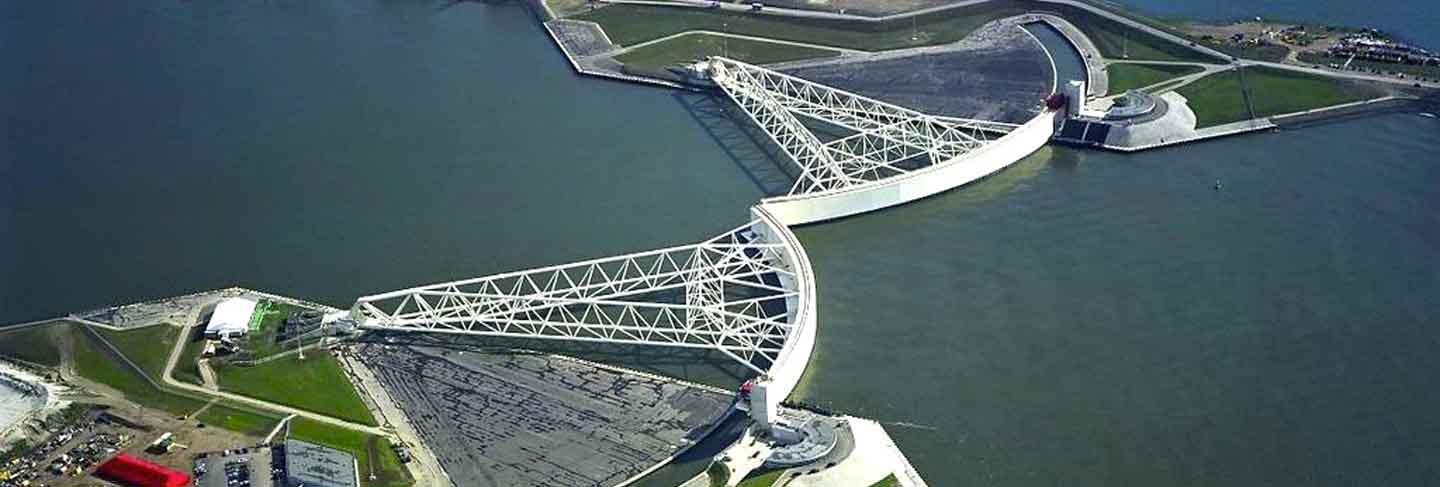The Maeslantkering is a storm surge barrier on the imaginary dividing line between the Nieuwe Waterweg (New Waterway) located at Hoek van Holland and the river Scheur located along the cities of Maassluis and Vlaardingen up to the confluence of the rivers Oude Maas and Nieuwe Maas, Netherlands which automatically closes when needed. It is part of the Delta Works and it is one of largest moving structures on Earth, rivalling the Green Bank Telescope in the USA and the Bagger 288 excavator in Germany.

The construction of the Maeslantkering was a part of the Europoortkering project which, in turn, was the final stage of the Delta Works. The main objective of this Europoortkering-project was improving the safety against flooding of the Rotterdam harbour, of which the Europoort is an important part, and the surrounding towns and agricultural areas. This had to be carried out by the reinforcement of existing dikes as far as 50 kilometres inland. During the 1980s it became clear that this project would take at least 30 years and would cost a huge amount of money. It would also mean that historic town centres, sometimes built more than four centuries ago, had to be broken down and rebuilt behind renewed, larger dikes.
Therefore, the initial plan was put aside and the Ministry of Waterways and Public Works organised a competition in which construction companies could make plans for the construction of a reliable yet relatively cheap storm surge barrier.
This storm surge barrier had to be located in the waterway (Nieuwe Maas - the Scheur - Nieuwe Waterweg) that connects Rotterdam with the North Sea. This played an important role in the planning stage of the construction, as this waterway is the main route to the port of Rotterdam, at that time the world's largest port. Therefore, a barrier like the Dutch Oosterscheldekering and the Thames Barrier could not be constructed, as such a barrier would block the shipping route.
The winning plan called for two large floating gates on both dikes of the waterway. A major advantage of this plan was that construction of the storm surge barrier could take place under dry conditions, in dry docks. Other advantages were that no vital parts of the barrier had to be placed under water, and maintenance of the barrier would be easy because of the dry docks. Finally, there would be almost no inconvenience for passing ships. The winning plan was put forward by the BMK consortium (Bouwcombinatie Maeslantkering). This consortium included the contractors HBG (now BAM), Volker Stevin and Hollandia Kloos. The storm surge barrier project was one of the first large Design and Construct projects for which the contractor also prepares the design.
The construction of the barrier started in 1991. First the dry docks were constructed on both shores and a sill was constructed at the bottom of the Nieuwe Waterweg. Then the two 22-metre high and 210-metre long steel gates were built. After this, 237-metre long steel trusses were welded to the gates. Standing upright, these arms would be as high as the Eiffel Tower, and each one weighs almost as much at 6,800 tonnes.
The main purpose of the arms is transmitting the immense forces, exerted on the gates while closed, to one single joint at the rear of each gate. During the closing or opening process, this ball shaped joint gives the gate the opportunity to move freely under the influences of water, wind and waves. It acts like a ball and socket joint, such as in the human shoulder or hip. The joints were made in the Czech republic at Skoda Works. The ball-shaped joint is the largest in the world, with a diameter of 10 metres, and weighing 680 tonnes. The construction of the barrier cost 450 million euro. The total Europoortkering-project had cost 660 million euros.
A working 1:250 scale version of the barrier was constructed in the Madurodam miniature village. Its construction took six months. It took six years to construct the real barrier.
Reference(s) ..www.deltawerken.com
